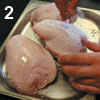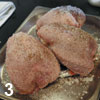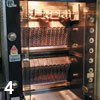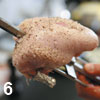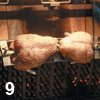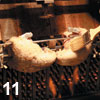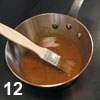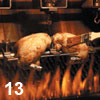Spit-roast chicken
It's tempting to view the revival of classic cuisine as a backlash, a reaction to a Heston-Adrià axis, dominated by novelty. In fact, mainstream restaurants are also responsible. For decades, ever since the nouvelle cuisine experiment, it has suited chefs, especially those at the top of the pyramid, to serve a main course that is seared in a pan on top of the range. It has suited them to plate up food under the lamps in the kitchen. Setting aside the practical advantages, it leaves restaurants open to the charge of tarting up, basically boring lumps of protein.
When he opens La Noisette in London's Jumeirah Carlton Tower hotel next week on 13 July, chef Bjorn van der Horst will present a menu showing off the range of cooking techniques that would have been familiar to Escoffier. This commitment, if it is to work, adds a level of risk. In the kitchen, chefs will have to learn how to spit-roast a chicken to order. Waiting staff will have to rediscover the tricks of guéridon work, from carving to crêpes suzettes. The linkage between front of house and kitchen will be more complex than is usual today.
Essentially, La Noisette aspires to be the kind of French, cuisine bourgeoise, restaurant that was once the bedrock of France's international culinary reputation.
If the concept is retro, the dishes themselves need not be in a time warp. Their textures, colours and tastes reflect a world that has opened up. The nature of what is classic in 2006 is different from what it was a century ago.
BJORN VAN DER HORST When Bjorn van der Horst moved into his new Sloane Street premises he looked at the shops on either side of the road - Chanel, Dior, Valentino, Prada - and realised they had achieved their status over time by sticking to what they did best. It's a lesson he wants to apply to La Noisette. Having learnt how to cook in great French kitchens, including a six-year stint working for Alain Ducasse, he respects tradition. He wants to echo the qualities which brought his mentor three Michelin stars: a combination of skill and consistency.
Under the umbrella of Gordon Ramsay's stable of restaurants, he has been given a free hand to develop a menu and a style of cuisine that earned him recognition at Marlon Abela's Greenhouse and before that at New York's Picholine and Gaia.
Van der Horst first visited London in 1989 when he entered the Gavroche kitchens. The Roux Brothers encouraged him to use his gift for languages by travelling. At La Noisette he has been given the opportunity to show whether he can compete with the world's best.
Spit-roast chicken
Spit-roasting at La Noisette may be a kissing cousin of the supermarket rôtisserie, but it's not the same thing. Nor is it the same as oven-roasting. Nor is it quite the method that would have been practised in the day when spits were turned by dogs on treadmills.
A 1,300-1,400g chicken provides two breast portions.
Advance preparations
Basting gravy Work on the basis of 1kg bones, 250g onion, half a head of garlic and trimmings to two litres of water; double up as necessary. Chop chicken trimmings, including skin and any fat. Add halved onion and garlic. Brown in a very hot oven about 15 minutes.
Transfer the chicken and onions to a saucepan. Add a little water to the pan in which they browned. Deglaze by scraping any residue off it and add to the saucepan.
Add the rest of the water. Bring to the boil. Don't skim, as would be normal for a stock. Let the broth boil very gently for an hour. It will reduce somewhat, and become cloudy.
Add thyme to taste and leave to infuse off the heat. Strain the broth, taste it, but don't add salt.
Chicken crowns These provide the trimmings for the gravy. Lift the skin above the wishbone. Scrape the inside of the wishbone to expose it. Loosen it and pull out.
Remove the chicken legs: hold a leg away from the carcass, cut through the skin and pull the thighbone back against the joint to dislocate it.
Cut through the ribcage on either side of the breasts and break off the backbone. Cut off the winglets. Expose the wing bones and wrap foil around them. Put a sprig of thyme under the breastbone.
ROASTING
Preparing the chicken
Brush the skin all over with olive oil (1). Sprinkle with Maldon salt (2) and rub it into the skin (3).
Bjorn van der Horst uses about 40g per bird, which may seem a lot, but most will drip off during the roasting process. If the skin is heavily salted, the fat in it will dissolve and the skin, especially on a young tender bird, will be thin and not crisp.
Preheat the rôtisserie (4). It will be hotter at the top than below, where the open flame is. Fit the drip tray (5).
To skewer the chicken on the spit (6), it has to be threaded on to the bar between two, two-pronged "forks" that need to be adjusted so it remains tightly in place.
Fit one of the forks on the bar. Hold the crown at the end of the bar. The tapering end of the crown should be pointing towards the fork.
Thread the bar under the breastbone and through the cavity where the wishbone has been removed.
Push the crown back to the fork and fasten the crown tight against it (7). Tighten the nut on the fork to hold it in place.
Fit a second fork on the bar. Press it up tight against the crown so that the spikes penetrate the breast just above the winglets. Tighten the nut on the fork to hold it in place.
When several birds are placed on the same spit (8), fit them so the sharp end presses into the rounded end of the breast.
Roasting and basting
Time depends on the thickness of the muscle, the heat of the rôtisserie and the amount of basting.
INGREDIENTS Melted butter
Basting gravy
Water to stop fat burning in the drip tray
METHOD
Fit the spitted chicken in the rôtisserie (9).
After two or three minutes the skin will start to whiten and shrink. Brush the chicken with melted butter (10, 11). After four or five minutes, when the skin starts to blister, brush it all over with basting gravy (12). If the fat in the drip tray starts burning, splash water on it. This produces steam, but not enough to affect the roasting.
Continue to baste with basting gravy (13). It will be ready after 20 minutes. Take it off the spit and leave it to rest before service.
ROAST CHICKEN WITH PERSIAN RICE AND CONDIMENTS
The planning process behind the dish
To find a practical dish that would make good use of the rôtisserie.
The dish had to have a classic pedigree.
It had to be adapted to the season, but be appropriate for three months.
It needed to suit the service style of the restaurant.
The look had to be colourful and appetising.
A Mediterranean twist reflected Bjorn van der Horst's own background and personal taste.
INGREDIENTS (Serves two)
1 spit roast chicken
150g cooked basmati rice with rice almonds, lemon confit and sumac powder
60g roasted peppers
60g Lebanese tabbouleh
60g baba ganoush
60ml lightly reduced basting gravy
METHOD To serve the dish in front of the customer, the waiter brings the different elements to the table on a guéridon. He puts rice on to each plate to one side, a little gravy next to it and lays slices of freshly carved aiguillettes of chicken breast overlapping the rice. The pots of peppers, tabbouleh and baba ganoush are left on the table for customers to serve themselves.
For the Persian rice polow for about eight
Wash 500g basmati rice in several changes of water until it runs clear. Heat 100g butter or butter and oil in a heavy duty pan until it sizzles.
Sprinkle a layer of rice over it. Fry without stirring till the base starts to catch. Pour over enough cold water to come 3cm over the top of it. Add salt. Boil one minute. Cover with a tight-fitting lid and leave to steam in its own heat.
To serve, add toasted, flaked almonds to taste, shreds of lemon confit and a dusting of sumac powder.
(Vacuum-cooked salted lemons: Halve, salt 24 hours with some sugar and vaccum-cook 15 hours at 48°C)
For the roasted peppers for about eight
Remove the central stalk from four yellow or red peppers. Salt them on the inside and put a clove of garlic in each one. Char them until the skin can be scraped off easily. Slice them not too finely and marinate in olive oil.
For the tabbouleh for about eight
Soak 30g of fine-grained burghul. Combine with 250g coarsely chopped parsley with mint and coriander leaves to taste. Season with olive oil, lemon juice, salt and allspice.
For the baba ganoush for about eight
Thoroughly blacken and char the skin of a large aubergine. By then the flesh should be cooked through. If not, finish cooking it in the oven or in a microwave. Scrape off the burnt skin. Blend the flesh with olive oil, salt, cumin and ground coriander seeds.
Texture and La Noisette Menu A customer ordering a three-course meal might choose foie gras served on an espresso syrup with a nougatine and almond foam where the surface of the foie gras had been made crusty by flashing it under the salamander. The main course might be a navarin of lamb, baked like a daube to a melting texture and served from a cast iron pot, or the roast chicken. Dessert could be a peach melba in an almond tuile tulip with a caramel cage over it and a raspberry candyfloss accompaniment.




